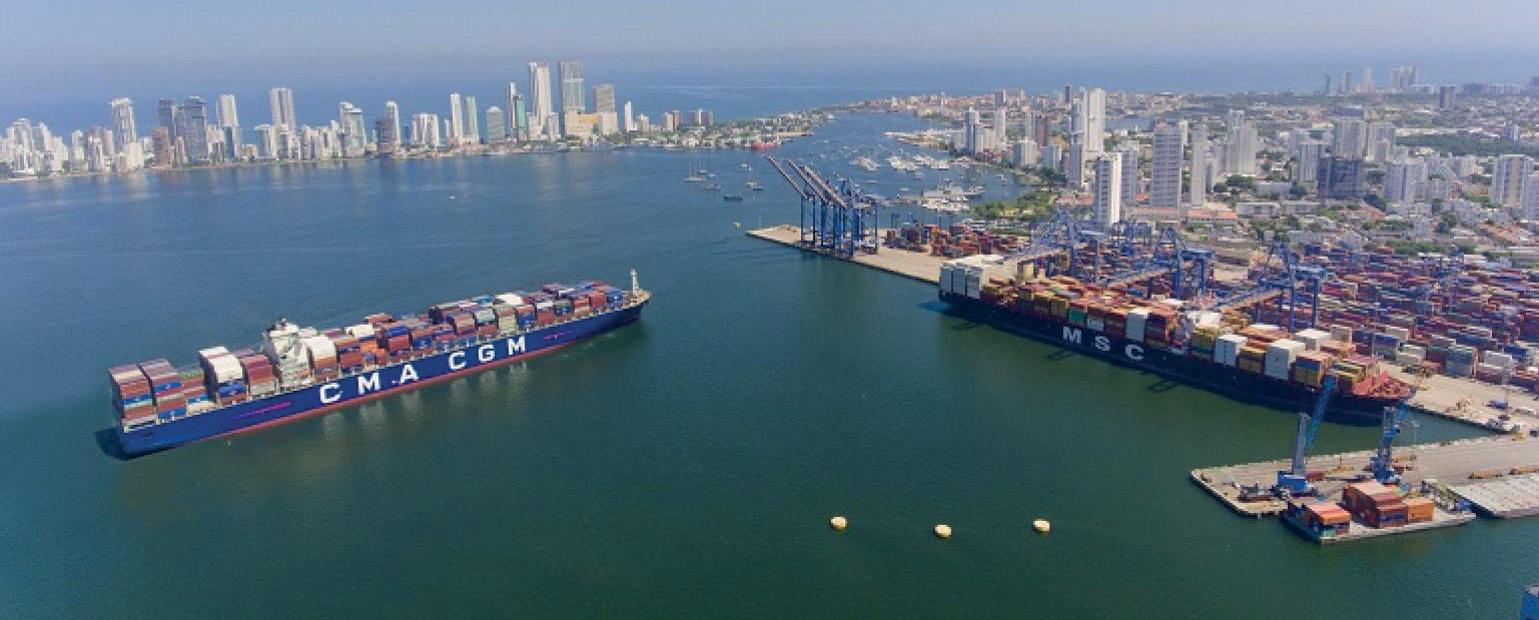
8 minute read
A Boom Year
BOOM YEAR FOR CARTAGENA
‘One man’s pain is another’s gain’ and so it has proved for Cartagena as it capitalises on a cocktail of problems in Buenaventura. Rob Ward explains
Usually known for its role as a key Caribbean transshipment port, Cartagena, on the north Colombian coast, will break its annual throughput record this year for both import and export cargoes and could soon overtake beleaguered Buenaventura as the leading handler of domestic cargoes.
Cartagena registered spectacular growth in both import and export boxes during the first half of this year, with the former jumping by 22.2% (from 157,361TEU up to 192,286TEU) and the latter rising by 20.5 per cent (from 113,501TEU up to 136,834TEU). If throughput continues at its current (first six monthly) rate both these indices look set to break their annual records: exports out of Cartagena peaked at 218,715TEU last year and imports peaked at 339,676TEU in 2019. Overall throughput for this year, with transshipment, is forecast at 3.2m to 3.4 million TEU, breaking the 3 million TEU per annum barrier for the first time.
On top of this, with its rival for Asian cargoes, Buenaventura, seemingly in meltdown since May of this year due to a truckers strike and various outbreaks of civil unrest, it has been picking up extra containers from that beleaguered Pacific port. It is understood that many shippers – especially coffee producers and car and motorbike parts’ importers - in the hinterland between Buenaventura and Cartagena are considering using the Caribbean port on a regular basis, and the same goes for shippers based in and around the country`s capital, Bogota.
“Yes, it looks like we will handle record numbers of nontransshipment boxes this year and our latest forecasts are for 820,000TEU in this category [including empties],” says Sebastien Gomez, commercial manager, Sociedad Portuaria Regional de Cartagena (SPRC) which operates both the SPRC and Contecar terminals in Cartagena. “It really has been a phenomenal achievement in terms of domestic imports and exports, both dry and reefer.”
Of that 820,000TEU, some 646,000TEU is of full boxes (including reefers, totalling 49,500TEU) and 174,000TEU will be empties. That would give Cartagena a 22.73 per cent rise in full containers (up from 526,400TEU in 2020) and an extra 119,600TEU (including reefers).
Gomez puts the huge increase during the first half of 2021 – up 20.08% over the same period of 2020 - down to three reasons.
The first is the re-activation of companies and their factories in both Colombia and abroad after months of closures and restricted operations.
Second is “the strikes and political situation in Buenaventura with many shippers re-directing their boxes to Cartagena”. Third is the widespread knowledge among shippers and shipping lines that Cartagena had “a lot of spare capacity and the ability to deal with a sudden surge of extra containers”.
Ricardo Sanchez, the Senior Economic Affairs Officer of the International Trade and Integration Division of ECLAC (Economic commission for Latin America and the Caribbean), adds a fourth; the dire dredging problem in Buenaventura that has seen the maximum draft fall from more than 14 metres to around 12.5m, leading to shipping lines scrapping direct calls to the “problematic Pacific port” from their WCSA to Mediterranean services, at the end of 2019 and early 2020, preferring transshipment from Panama or Cartagena.
“When choosing between the deep draft in Cartagena [16 meters] and the decreasing draft in Buenaventura it is small wonder carriers prefer the former for transshipment and that has a knock-on effect, in terms of options, for domestic cargoes,” Sanchez explains to Port Strategy.
Now the challenge, says Gomez, is to keep as much of that “new business” as possible and, he estimates, around 40% of the transferred cargoes will still be using Cartagena by the
8 The greater
stability of Cartagena is proving attractive to cargo shippers including the important coff ee exporters and automobile producers
middle of next year. This is on top of the “extra transshipment cargoes” that SPRC picked up after several carriers scrapped their direct calls to Buenaventura over the past two years (See feature in last edition of Port Strategy).
“We do hope, and we are working hard, to keep a good percentage of those cargoes that have shifted over to us from Buenaventura, especially coffee export boxes and motorcycle and car parts. We are also targeting shipments to and from Bogota,” he notes
COFFEE ON THE UP
Coffee shipments via Cartagena increased by 35.4 per cent during the first six months of this year, according to SPRC, jumping from 4,926TEU to 6,664TEU and, despite most plantations being in the south and close to Buenaventura, many coffee exporters are considering using Cartagena on a regular basis, at least for some of their shipments so that a logistics chain via the north coast is in place if Buenaventura continues to implode in the future. Although trucking costs will be much higher using Cartagena, shipping costs will be less because coffee boxes won’t have to be transshipped out of Buenaventura.
As Gomez explains; “One of the main drivers of the coffee exports is the inland transport costs, which are extremely high for coffee harvests from the south of the country such as Nariño, Huila, etc, which are the biggest harvest zones. “Despite that we had a huge peak in coffee exports in June and July, with the boxes hitching a ride to China and the Far East via US East Coast to Asia services, via the Panama Canal.
“However, keeping an extra share of coffee exports, especially to Asia, is an extremely hard task because logistics costs, especially trucking, for exporters would be very high. We have seen that many clients, so as to minimize the risk of another strike and issues, are planning to maintain a constant quota in Cartagena that used to be from Beunaventura.”
He adds that Cartagena could increase its overall share of the coffee export market from 28 per cent in 2020 to 35 per cent by the end of 2021, with Buenaventura handling the rest.
Car and motorcycle manufacturers/assemblers are more scattered around Colombia than coffee plantations and Gomez has also reported “significant increases” from this sector, and with GM based in Bogota and Renault, Kawasaki and Yamaha located in Medellin, he hopes to keep some of that re-directed cargo, despite Bogota being up to 20 hours distant by truck, when Buenaventura is only 15 hours, albeit over difficult mountainous terrain.
BRIDGING THE GAP
With the forecast increases Cartagena will bridge the “domestic cargo gap” between it and Buenaventura and likely take over the mantle of leading Colombian port for domestic containerised cargoes from Buenaventura in the near future. The Pacific port has seen movement fall from 1.39 million TEU in 2018 down to just over 1 million TEU in 2020 (after two consecutive annual falls of 12.4 and 15 per cent) and with a forecast for 2021 of somewhere around 900,000TEU.
SPRC operates the two box terminals in Cartagena - Contecar and Manga – with 21 super post panamax Gantry Cranes (SSGCs), and 3900 reefer plugs and it added two Gottwald Mobile Harbour Cranes in 2020. With a capacity of 5.2m TEU Gomez says it can deal with more sharp increases but will be looking for more equipment next year.
In the meantime, Puerto Bahia, which has been operating ro-ro in Cartagena for the past six years, has been observing the boom in container handling and may add some “empty container handling” operations at the port “in the near future”, to add some competition to SPRC.
One Bogota based shipping agent, who did not wish to be named for fear of reprisals, told Port Strategy: “In recent years, and especially this year since strikes and riots in May, Buenaventura has become a basket case and many shippers are seeking alternatives such as Cartagena, Barranquilla or Santa Marta.
“There are a lot of gangs operating in and around the port area and they make security for port workers, officials and truck drivers a major concern.”
Port operations in Buenaventura got so difficult in May and June, that several shipping lines, including Maersk, CMA CGM and MSC, stopped calling at the troubled port for a period.
Two other ports on the Colombian north coast – Santa Marta and Baranquilla – also seem to have benefitted from the malaise afflicting Buenaventura, with Santa Marta averaging 150,000TEU over the past few years (up from 50,000TEU previously) and Baranquilla handling 81,000TEU during the first half 2021, up 15 per cent and 10,000TEU on last year, and much of it re-directed from Buenaventura.
SPRC are also the operators of the cruise terminal in Cartagena - a UNESCO World Heritage city that is one of the most popular cruise destinations in the Caribbean – and in August they tentatively re-started a new season - with the 300 passenger Windstar Cruises Star Breeze calling - after the 2020-21 season was completely wiped out by Covid.

8 “It really has
been a phenomenal achievement in terms of domestic imports and exports, both dry and reefer,” Sebastien Gomez, Commercial Manager, SPRC


















